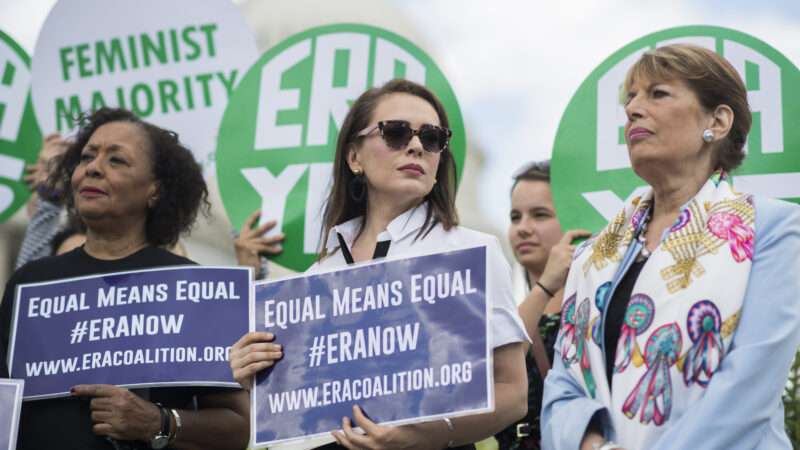

Last week, a group of primarily Asian-American parents filed a lawsuit challenging the constitutionality of new admissions policies at the Thomas Jefferson High School for Science and Technology, in Fairfax, Virginia. The case could end up setting an important precedent:
Thomas Jefferson High, known as TJ, often ranks as the best public high school in the nation — but is also nationally known for struggling to admit Black and Hispanic students, who have comprised single-digit percentages of the student body for decades. By contrast, Asian American students made up 70 percent of the student body in 2019-2020, although Asian families accounted for 30 percent of Fairfax County’s population in 2019…
In late December, the board approved a “holistic review” process that invites qualified eighth-graders — those with a grade-point average of at least 3.5 and enrolled in various honors courses — to apply by completing an essay and a “Student Portrait Sheet…”
That overhaul is the focus of the new lawsuit. It was filed by members of the Coalition of TJ, a group formed by parents and school alumni last year to fight the proposed admissions changes…..
The 25-page suit, filed Wednesday in the U.S. District Court for the Eastern District of Virginia against Brabrand and the Fairfax school board, charges that the revisions to TJ’s admissions process were specifically meant to drive down the number of Asian American students enrolled at the school and cites presentations and comments made by the superintendent and school board members to try to prove that point.
As described in the complaint filed by the plaintiffs, the key to the new admissions system is a system under which the previous admissions test (on which Asian-American applicants tended to score well) is eliminated, and replaced with a “holistic” evaluation system under which there are caps on the number of students who can be admitted from any given middle school in Fairfax County. The latter would have the effect of greatly reducing the number of Asian-American students accepted, because Asian students are disproportionately concentrated in some middle schools, relative to others.
The TJ case could sent important precedents on two major issues: how to deal with cases where racial affirmative action policies are pursued by policies that are facially neutral, and how to address situations where a major goal of the policy is to reduce the number of Asian-American students.
The mere fact the new admissions system would result in fewer Asian-American students does not make the policy unconstitutional. Neither does the possibility that the new policy might reduce the quality of education at TJ overall. Rather, the problem is that extensive evidence indicates that the change in admissions policy is motivated by policymakers’ desire to reduce the percentage of Asian-American students, so that the TJ student body will more closely reflect the demographics of the region. The plaintiffs’ complaint gives many examples, such as this one:
At the school board work session on October 6, 2020, when the Board voted to eliminate the TJ admissions test, the discussion between the Board and Brabrand make it clear that racial balancing was the goal….
[TJ] Principal Bonitatibus again highlighted the desire for a “student body that more closely aligns with the representation in FCPS” and “Northern Virginia…” Board Member Abrar Omeish stated that a key point was to “make sure there’s representation” that “should be proportional to the population numbers” of Fairfax County.
The complaint also details how state and county officials involved in discussions that led to the reforms voiced various negative stereotypes about Asian-American parents and students, including that they put too much emphasis on test preparation, and that having too many of them damages TJ’s “culture.” In one particularly egregious example, state legislator Mark Keam denounced the “unethical ways” Asian-American parents “push their kids into [TJ],” when those parents are “not even going to stay in America,” but instead are “using [TJ] to get into Ivy League schools and then go back to their home country.”
If the board’s new policy is implemented, the principal effect will be to greatly reduce the percentage of Asian-American students at TJ, while greatly increasing the percentage of whites. The complaint notes that population of Fairfax county is currently about 61% white, 10% Black, 16% Hispanic, and 19% Asian and Pacific Islander (numbers add up to more than 100% because “Hispanic” residents in the survey can be members of any racial group; thus, many are also listed as “black” or “white”).
The student body at TJ is currently 73% Asian-American, 1% Black, 3.3% Hispanic or Latino, 6% other, and 17.7% white. If, as County school officials indicated, the goal of the new policy is to get a student body that is “proportional” to Fairfax’s population demographics, the biggest change would be an increase in the percentage of non-Hispanic whites from the current 17.7% to somewhere between 50 and 60%, though the percentage of blacks and Latinos would also increase. The plaintiffs’ analysis estimates that the new admission system would, in fact, result in a student body that is roughly 31% Asian-American, 5% Black, 8% Hispanic or Latino, 48% white, and 8% other.
The Supreme Court has long held that seemingly neutral government policies whose real goal is to discriminate on the basis of race or ethnicity are presumptively unconstitutional and subject to “strict scrutiny” in much the same way as policies that openly discriminate. Under Village of Arlington Heights v. Metropolitan Housing Development Corporation (1977), the leading precedent in this field, once the plaintiffs provide any significant evidence that the policy was motivated by racial or ethnic discrimination, the burden shifts to the government to prove they would have enacted the same policy even in the absence of racial motives. If they cannot do so, the policy is subject to searching strict scrutiny, and is likely to be struck down. In this case, it will be very difficult for Fairfax County to show that they would have adopted the same policy even in the absence of the racial balancing goals that key officials openly said were their main objectives.
While there are many such “pretextual discrimination” rulings in cases involving traditional racial discrimination against minorities, we have not yet had a significant decision in a case where the challenged pretextual policy is an “affirmative action” seeking to promote “diversity” or racial balancing. The TJ case might fill that gap. And it could open the door to challenges to similar pretextually motivated policies, such as the Texas “Top Ten Percent Plan.”
The other big reason why this case might set an important precedent is that it involves a “diversity” or “affirmative action” plan where the principal victims are Asian-Americans. Disproportionate effects on Asian-Americans have come up in other cases, most notably the currently ongoing litigation against Harvard’s affirmative action policies. But none of them involve targeting of Asian-Americans as blatant or as large-scale as in this case. And none involve a situation where it is so clear that the primary beneficiaries of the new policy will be whites, even though officials clearly also want to increase the percentage of African-Americans and Hispanics.
For reasons I have expounded on several times previously (e.g. here, here, and here), racial preferences that disadvantage Asian-Americans are at odds with both the compensatory justice and “diversity” rationales for affirmative action:
The Asian-American case… highlights the contradiction between the compensatory justice and diversity rationales for affirmative action in admissions… If the goal of affirmative action is to compensate minority groups who have been victimized by discrimination for the injustices they have suffered, many Asian-American groups deserve not only equal treatment but racial preferences. Chinese and Japanese-Americans, for example, were victimized by extensive state-sponsored discrimination – culminating in the internment of some 100,000 Japanese-Americans during World War II… It’s true, of course, that these groups are relatively affluent today. But that fact has little relevance to issues of compensatory justice. If you steal from someone and they later strike it rich, that does not diminish the validity of their claims for compensation….
If, on the other hand, the goal of affirmative action is to promote “diversity” for the sake of ensuring that each ethnic group is represented by a “critical mass” in the student body sufficient to educate other students about their culture, then the lack of affirmative action for Asian-Americans becomes more understandable. Because of their impressive academic credentials, a critical mass of Asian students can be achieved even without affirmative action preferences. However, this conclusion may be overstated. “Asians” are not a monolithic group. Japanese, Chinese, Indians, Filipinos, Vietnamese, and Cambodians all have very different cultures. Indeed, immigrants from one part of India or China often have different cultures and speak different languages from those hailing from other parts of the same nation. Treating them all as an undifferentiated mass of “Asian-Americans” is a bit like saying that Norwegians, Italians, and Bulgarians are basically the same because they are “Europeans.” If diversity is really the goal,… administrators should do away with the artificial “Asian-American” category altogether and start considering each group separately. They should do the same for the many groups usually lumped together as “white” or “Hispanic.” A university that already has a critical mass of native-born-WASPS might well not have a critical mass of Utah Mormons or Eastern European immigrants.
Defenders of programs intended to reduce the percentage of Asian-American students in elite high schools and universities often point out that these policies do not completely exclude Asians, in the way that Jim Crow-era segregation policies totally excluded blacks from white schools. In the TJ case, the new policy would result in a school where some 30% of the students are Asian-American—which is higher than their percentage of the Fairfax County population.
It is indeed true that the TJ policy and others like it are not as bad as Jim Crow, despite attempts to equate the two by some conservatives. But they still deliberately disadvantage Asian students based on their race. That is a grave injustice even if it is less awful than Jim Crow was.
And while comparisons to Jim Crow are overstated, there is a closer historical parallel to early-twentieth century policies intended to limit the number of Jewish students at elite educational institutions. As in the case of Asian-Americans today, education administrators back then argued that having too many Jews would undermine desirable diversity, and damage the school’s “culture.” Much like Asian students today, Jewish students in that era were stereotyped as overly focused on grades and test scores, and not interested enough in sports and social activities.
And, as with the TJ policy of using middle school caps and “holistic” policies to keep down the number of Asian students, administrators at Ivy League universities used geographic preferences and “character” evaluations, as a seemingly neutral proxy for keeping down the number of Jews. These types of policies fell far short of completely excluding Jews from the elite institutions that adopted them. But they did significantly reduce the number of Jewish students who were able to attend them.
Today, almost everyone regards these anti-Jewish policies as a shameful episode in the history of American education. But today’s very similar efforts to reduce the number of Asian-American students suggests we haven’t learned the lessons of history as well as we should have.
Defenders of affirmative action sometimes argue that Asian-American opponents are being used or exploited by white conservatives. That may well be what some white politicians and activists are trying to do.
But Asian-American concern about racial preference policies that target them long predates most white conservatives’ interest in the issue. Some thirty years ago, I attended a public high school with a large Asian-American population. Even back then, racial preferences were a major focus of conversation and concern among my Asian-American classmates applying to elite colleges. The key role of Asian-Americans in the recent defeat of California Proposition 16 (which would have restored racial preferences in education in that state), also cannot easily be ascribed to conservative manipulation. Asian-Americans in that state are overwhelmingly liberal Democrats, and unlikely to take their cues from white conservatives. If there is an opportunity here for conservatives to exploit, it is in large part because of preexisting Asian-American opposition to policies intended to reduce their access to elite educational institutions.
There is much that Virginia policymakers can do to improve educational opportunities for disadvantaged students of all races, without targeting Asian-American students, or engaging in racial preferences of any kind. For example, they could back initiatives to abolish the exclusionary zoning that prices many poorer families out of living in parts of the region with strong school systems.
If instead they choose to promote racial balancing at selective institutions by targeting Asian-American students, they can expect more challenges like this one. Hopefully, the TJ case will set a valuable precedent curbing such practices.
NOTE: My wife, Alison Somin, works for the Pacific Legal Foundation, the public interest law firm representing the plaintiffs in the TJ case. She is also one of the lawyers working on this case, specifically. As the links in the above post demonstrate, I have written about these sorts of issues since long before Alison accepted a position at PLF last year, and my views are much the same as they were before she did so.
from Latest – Reason.com https://ift.tt/3tq2Q3s
via IFTTT




